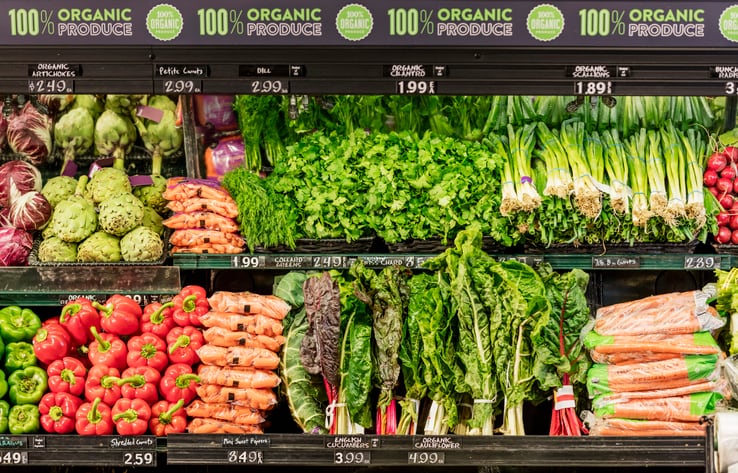Consumer demand for cleaner ingredients and products “free-from” chemicals, dyes and unnecessary additives is helping organic sales steadily rebound after a “pandemic correction” in 2021 caused sales growth to slow to 2.3% after surging 12.7% in 2020, according to new data from the Organic Trade Association.
Year-over-year US sales of organic certified products in 2024 increased 5.2% (or 2.2% when adjusted for inflation) to a new high of $71.6 billion over the previous year, which is more than double the overall marketplace’s growth of only 2.5% (or a declined 0.3% when adjusted for inflation), according to OTA.
This is the third year of a steady increase in sales growth for organic when adjusted for inflation. According to OTA, inflation adjusted organic growth in 2021 was -4.4%. The next year revealed incremental improvement with inflation adjusted organic growth of -2.2%, followed by 0% in 2023 and finally positive growth of 2.2% in 2024.
“Organic since 2021 has been on a recovery path,” OTA Co-CEO Tom Chapman said. He explained that the many organic businesses and farmers struggled to meet the “unanticipated demand spike in 2020,” but now they are better prepared as they have been able to transition more production to organic, a process that takes three years.
Health and wellness turbocharge organic food sales
Demand for organic food has climbed since the pandemic in large part thanks to consumers “looking for cleaner ingredients and consumers prioritizing health and wellness for themselves and their families,” Chapman said.
“Younger consumers, particularly Millennials and Gen Z, are helping to shape the grocery sales trends by balancing health-conscious choices with quality and indulgence,” he added.
For support, he pointed a year-over-year sales increase in 2024 of 5.2% for organic food sales to $65.4 billion, which was fueled by a 5.2% increase in organic produce, including a 10.3% spike in berry sales. Together, these helped offset a 4.5% drop in organic packaged salad sales, which Chapman categorized as another “correction.”
Sales of grocery, the second largest organic category, also grew 4% year-over-year to $15 billion in 2024, according to OTA.
Beverage is the third largest organic category, and Chapman noted it “is often cited as the category with the most innovation.”
He noted, “2024 was no exception. Sales for the organic beverage market grew by 5.2% to $9.5 billion with new formulations following consumer trends and wellness, including rising interest in lower sugar formulations and functional ingredients, as well as sustainability.”
Within beverage, sales of fresh juices and kombucha increased 4.6% to $2.03 billion, according to OTA data.
Consumer demand for nutrient dense products and protein helped boost organic dairy and egg sales an “impressive 7.7% to $8.5 billion in 2024,” said Chapman. He acknowledged that a 16.1% jump in egg sales likely was driven by avian flu-related shortages, but organic yogurt also helped boost the segment with a 10.5% sales growth increase – the second highest in 15 years.
Other winners included nutrition bars, which increased 7.4% to $1.9 billion, OTA revealed.
Strong growth ahead
OTA expects organic sales to continue growing at a compound annual growth rate of 5.1% through 2028 to reach $18 billion in sales by the end of the decade.
“We see this backed by a lot of consumer demographic information,” Chapman explained. “There is strong interest in organic among younger generations with increasing purchasing power, rising demand for healthier food, and increased discretionary income.”
He added, “We also are seeing positive trends from the health focus of GLP-1 medications.”
Finally, he noted, the Make America Health Again movement also is contributing to organic’s positive momentum.
Tariffs and labor shortages could slow organic growth
While OTA celebrated sales gains across food categories, Chapman also cautioned about headwinds, including the impact of tariffs and labor shortages, that could negatively impact the space.
“We do import more than we export” of organic, including of corn, soy and beef, he explained.
“Our major trading partners including Mexico and Canada, and in terms of imports, they make up 44% and in terms of exports that make up 67%. South America is our next largest importing partner. We see a lot of tropical crops and sugar coming from those marketplaces, followed by Europe, where we have a lot of high value imports, including olive oil and wine. Those four markets together total 75% of our imports on the export side,” he said.
Other constraints potentially hindering organic expansion including profit margins and price competitiveness, availability of organic ingredients and processing or handling or land, and cost of organic ingredients and production, Chapman said.
“We continue to focus our policy initiatives on ways that we can encourage additional supply for organic that will help support continued market growth,” he added.
Likewise, he said, investments and reforms are necessary to ensure organic products are available and meet evolving consumer expectations around health and sustainability.

